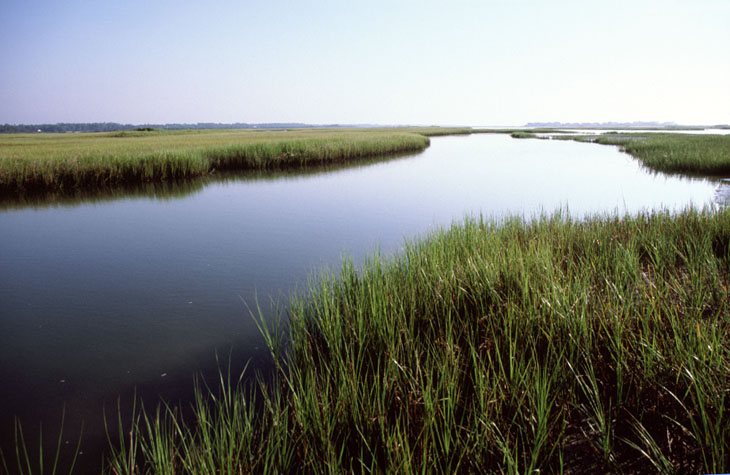
“Middle of nowhere.” This is one of those phrases that have gradually gotten more annoying to me over time, and I realize now that it subtly says a lot about our society, and perhaps even influences our reactions.
The middle of nowhere tells us that it’s far from roads, and restaurants, and telephones, and people overall – this is, supposedly, the “nowhere” bit. Nowhere has nothing of any interest to it, no reason to want to go there. What would you do there? What’s there to see?
As you might imagine, I try to get to the middle of nowhere for photography every chance I get, and images from such places are pretty popular – I’ll even selectively compose some shots to make them appear to be more isolated. While our anthropocentric thinking portrays the lack of human influence as the lack of anything important, that’s really the only thing that we use to define nowhere. There could be anything, from lush forests to sculpted sand dunes, pristine snowfields to wide-open water. And you’ll notice that just choosing the right descriptions changes the idea from nowhere into something attractive ;-)
 Obviously, there is no place that’s nowhere – there’s an implied following word: nowhere good, nowhere nice, nowhere interesting, nowhere important… whatever. (Reading that last string of phrases makes me feel sorry for anyone trying to learn this language, because they really don’t make sense, do they?) But how much are we affected by using such terms? When we’re isolated from so much of our human accoutrements, are we feeling alone, desolate, or abandoned? Does this make us, even subtly, fail to appreciate what we’re actually surrounded by? Do we ignore that the lack of trash, of industrial noise, of exhaust fumes is actually a remarkably pleasant thing? Are we conditioned to miss the interactive system right at our feet, millions of lives playing out in the dance of energy and ecology that encompasses the planet? Or, can we actually enjoy the lack of human contact for a while and drink in the sound of the grasses and the taste of the air? Do we, however subtly, recognize that we’ve taken our technology and ‘civilization’ a bit too far and need to leave it behind, if only for a few minutes or hours?
Obviously, there is no place that’s nowhere – there’s an implied following word: nowhere good, nowhere nice, nowhere interesting, nowhere important… whatever. (Reading that last string of phrases makes me feel sorry for anyone trying to learn this language, because they really don’t make sense, do they?) But how much are we affected by using such terms? When we’re isolated from so much of our human accoutrements, are we feeling alone, desolate, or abandoned? Does this make us, even subtly, fail to appreciate what we’re actually surrounded by? Do we ignore that the lack of trash, of industrial noise, of exhaust fumes is actually a remarkably pleasant thing? Are we conditioned to miss the interactive system right at our feet, millions of lives playing out in the dance of energy and ecology that encompasses the planet? Or, can we actually enjoy the lack of human contact for a while and drink in the sound of the grasses and the taste of the air? Do we, however subtly, recognize that we’ve taken our technology and ‘civilization’ a bit too far and need to leave it behind, if only for a few minutes or hours?
I’m not getting all Nature Boy here, advocating a return to log cabins and earwax candles, and I appreciate many of our conveniences as much as the next person. I don’t view the entirety of nature as pleasant; I actually hate cold weather and don’t sleep well on the ground, not to mention how technologically oriented the photography and website are. But I hate cities more, and feel more desolate surrounded by streets and concrete and shops than I have ever felt when far from human influence. I’m willing to admit I’m kind of anti-social and don’t get much out of large groups of people, nor feel the need to ‘fit in’ or any of that jazz – maybe that’s rare. Or maybe not, when I see how travel agencies advertise their vacation spots, and hear how often the term “get away from it all” is used when the conversation turns to relaxation.
Like so many things these days, I start examining this from the perspective of evolutionary psychology. As a species, we have strong tendencies towards social interaction, which likely had a lot to do with how we arrived where we are today – cooperative species derive a benefit from multiple individuals working towards the same goals. Imagine if we had no roads or paths and had to get everywhere by making our own trails; imagine no cooks at the restaurants and we had to go into the kitchen and prepare our own meals (okay, I’m probably mangling the idea a bit now.) Suffice to say that cities are the extended manifestation of our social drives. Yet at the same time, we take a certain delight in vibrant landscapes, possibly from recognizing good places to live, hunt, and farm. And we seem to have a drive to explore too, seeking new places with this inherent idea that they will be even more interesting than where we are now, though this sounds rather peculiar when you think about it – there’s just as much chance, if not more, that such places will be worse. Regardless, we still delight in the majestic vistas, sometimes even because they’re the “middle of nowhere” and far from others.
So there’s a conflict. Like much of our lives, conflicts do not immediately get resolved in favor of one or another, but wobble back and forth, taking turns in which gets appeased at any given time, and sometimes abandoned when the hankering for another state of affairs gets too strong. Work or family or convenience may keep us deeper in the urban sprawl than we prefer, but we offset this with the efforts to distance ourselves whenever we can. It’s admittedly hard to pay the bills by traipsing around the wetlands (though I’m trying damn hard to accomplish this,) so we accept the bad with the good. Yet it still seems odd to call it “nowhere.”
Then again, maybe this subconsciously helps to keep such places from getting overrun, letting humanity concentrate in urban areas so some expanses of inhumanity remain in nice shape, providing us with the means to get away. This suggests that I may be working against us all here by reminding anyone about such areas, encouraging them to spend more time there and thus contributing to the number of people therein. Damn I’m so confused right now, but I take solace in the fact that my readership remains low. And now maybe I have to leave and go sit by a stream somewhere all alone, while I still can ;-)





















































 If you’re the least bit familiar with frogs and toads, you know that anything but the most cautious approach to any pond where they hang out will send them sailing off the bank into the cover of the water, or vanish beneath the surface if they’re in the water in the first place. This, however, is a set of rules that does not apply to mating season.
If you’re the least bit familiar with frogs and toads, you know that anything but the most cautious approach to any pond where they hang out will send them sailing off the bank into the cover of the water, or vanish beneath the surface if they’re in the water in the first place. This, however, is a set of rules that does not apply to mating season.
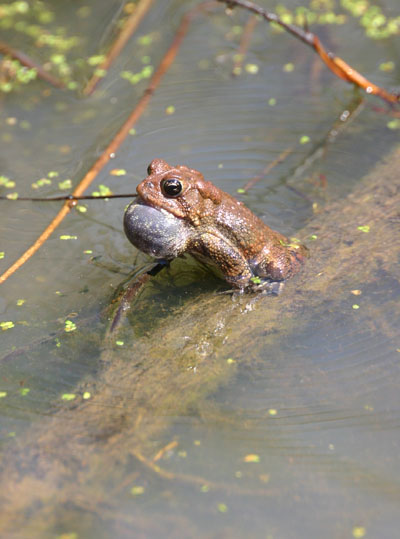 Here’s something that I didn’t notice until I was proofing the images after arriving home. I captured several toads perched in obvious locations and calling eagerly, but note the ripples surrounding this one, produced by the frequency of its calls. I have to say that this was subtle, because I missed it entirely even while taking numerous frames of several individuals. Then again, looking at the apparent point of origin of the ripples, maybe something else is at work here – do toads like beans? Maybe the calls are actually cover sounds, like how we cough loudly sometimes to disguise our, uh, nether emanations (yeah, like that ever works.) But then again I don’t see bubbles, so let’s stick with the mating calls as the culprit.
Here’s something that I didn’t notice until I was proofing the images after arriving home. I captured several toads perched in obvious locations and calling eagerly, but note the ripples surrounding this one, produced by the frequency of its calls. I have to say that this was subtle, because I missed it entirely even while taking numerous frames of several individuals. Then again, looking at the apparent point of origin of the ripples, maybe something else is at work here – do toads like beans? Maybe the calls are actually cover sounds, like how we cough loudly sometimes to disguise our, uh, nether emanations (yeah, like that ever works.) But then again I don’t see bubbles, so let’s stick with the mating calls as the culprit.
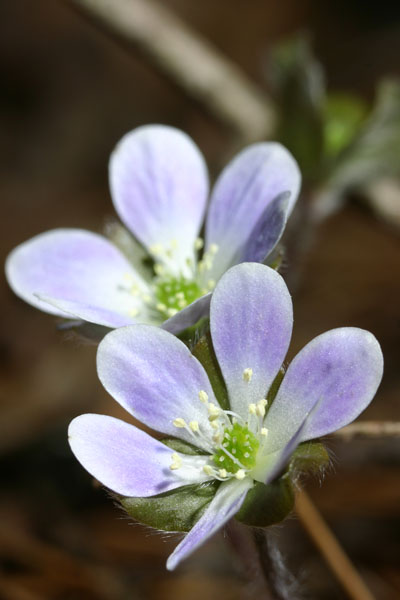 Here, we’re still wondering if spring has finally decided to settle in, or if its meds are going to wear off and send it scurrying for safety someplace, wherever spring goes when it’s not around – my guess is a shop that does specialty jams. The past few days have been spent dealing with the peripheral effects of a minor surgery – not mine, but that of The Girlfriend’s Younger Sprog, removing a bracing bar they’d put in earlier (make up your mind.) The surgery only took 40 minutes, but all the hoohah around it, not to mention the rescheduling because of an emergency that occupied the surgeon, meant two days of, really, not a damn thing happening while taking a very long time at it. The weather wasn’t bad then, though still a bit chilly, but now that all of that’s past I was able to take advantage of today’s warmth and went out looking for stuff, knowing full well that it’s still early yet.
Here, we’re still wondering if spring has finally decided to settle in, or if its meds are going to wear off and send it scurrying for safety someplace, wherever spring goes when it’s not around – my guess is a shop that does specialty jams. The past few days have been spent dealing with the peripheral effects of a minor surgery – not mine, but that of The Girlfriend’s Younger Sprog, removing a bracing bar they’d put in earlier (make up your mind.) The surgery only took 40 minutes, but all the hoohah around it, not to mention the rescheduling because of an emergency that occupied the surgeon, meant two days of, really, not a damn thing happening while taking a very long time at it. The weather wasn’t bad then, though still a bit chilly, but now that all of that’s past I was able to take advantage of today’s warmth and went out looking for stuff, knowing full well that it’s still early yet.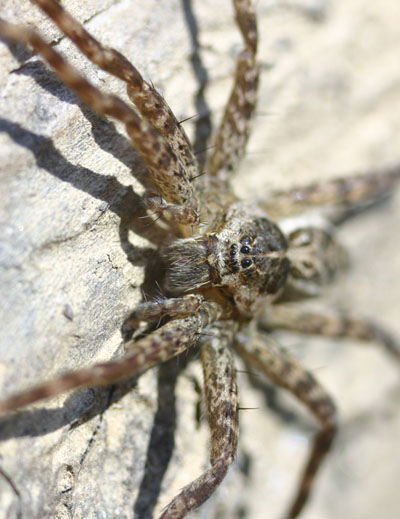 There was one fisher around who certainly did not miss me, no matter how you interpret that wording, and this was a targeted find, meaning one of the specific subjects I was looking for on this little trip. The same comments about shooting position apply here too, since I was on my side on a rock in the river, head hovering only centimeters over the water to get this portrait. While it may seem like I’ve flopped the image, the fishing spider (genus Dolomedes) was hanging out in just this position on the side of a log in the water, warming itself in the sun. They’re often pretty mellow and will allow a cautious approach, but I admit to coaxing this one to turn this way after it had shifted away from me, facing down into the water in a position that would have required a waterproof camera to nail the eyeball shot. Which makes me realize now that an image of the spider reflected from the water’s surface would have been supremely cool to obtain, even though the river was too turbulent here to attempt that – I’ll keep it on the list. I need to point out the other face visible, an owl-like visage on the abdomen – had you missed it? And yes, I remain true to form; a post without creepy things would make any regular reader (is there such a thing?) wonder what happened to me.
There was one fisher around who certainly did not miss me, no matter how you interpret that wording, and this was a targeted find, meaning one of the specific subjects I was looking for on this little trip. The same comments about shooting position apply here too, since I was on my side on a rock in the river, head hovering only centimeters over the water to get this portrait. While it may seem like I’ve flopped the image, the fishing spider (genus Dolomedes) was hanging out in just this position on the side of a log in the water, warming itself in the sun. They’re often pretty mellow and will allow a cautious approach, but I admit to coaxing this one to turn this way after it had shifted away from me, facing down into the water in a position that would have required a waterproof camera to nail the eyeball shot. Which makes me realize now that an image of the spider reflected from the water’s surface would have been supremely cool to obtain, even though the river was too turbulent here to attempt that – I’ll keep it on the list. I need to point out the other face visible, an owl-like visage on the abdomen – had you missed it? And yes, I remain true to form; a post without creepy things would make any regular reader (is there such a thing?) wonder what happened to me.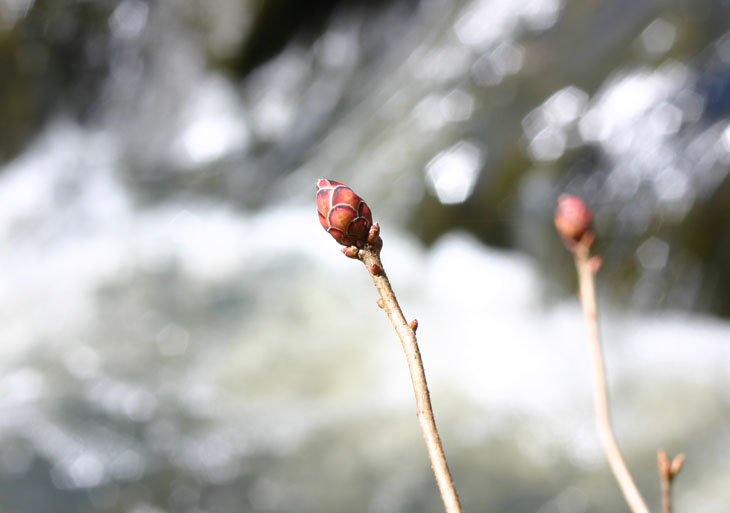
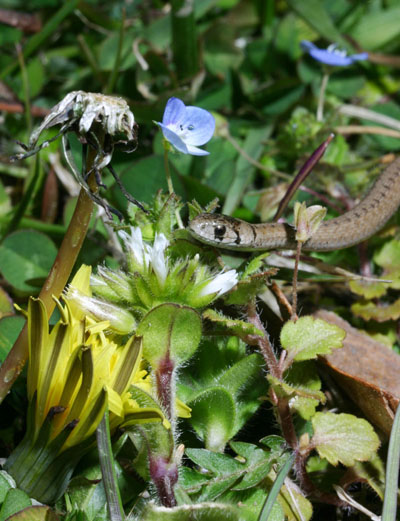 And the same with National Wildlife Week, which has just passed. Sure, wildlife is visible throughout the year, yet there are still times when you’re far more likely to be able to spot it than mid-March. The northern latitudes are still waiting on spring and may even be seeing late snowstorms, and here at the mid-latitudes of North Carolina we can see activity of the birds, but the best season comes when the spring’s newborns are leaving the nests or dens, and the plants that serve as food for so many species are leafing out in earnest. And from a photographer’s standpoint, a setting that includes actual foliage is only going to help.
And the same with National Wildlife Week, which has just passed. Sure, wildlife is visible throughout the year, yet there are still times when you’re far more likely to be able to spot it than mid-March. The northern latitudes are still waiting on spring and may even be seeing late snowstorms, and here at the mid-latitudes of North Carolina we can see activity of the birds, but the best season comes when the spring’s newborns are leaving the nests or dens, and the plants that serve as food for so many species are leafing out in earnest. And from a photographer’s standpoint, a setting that includes actual foliage is only going to help.

 There’s a reason that I show mostly tight closeups in pics taken locally, and it’s because my immediate surroundings are loaded in every direction with ugly landscapes – houses, fences, wires, cars, and so on. So presenting a better idea of how bad this time of year is for wildlife photography would require driving someplace more scenic just to show how un-scenic it is anyway, which seems almost pointless for a blog post. But perhaps I can still pull it off – this pic is from just now, out in the yard. The drop from the steady rain is acting as a lens, and what you see through it (inverted) is the bare tree that represents most of what’s visible right now – couple it with patchy brown grass and dead leaves on the ground and you have the idea. This is, by the way, a full color shot. It’s still an improvement over living in New York, but not by much, and I can’t help thinking we’re overdue for much better conditions. But at least you know what’s to blame for too many posts ripping philosophy or religion ;-)
There’s a reason that I show mostly tight closeups in pics taken locally, and it’s because my immediate surroundings are loaded in every direction with ugly landscapes – houses, fences, wires, cars, and so on. So presenting a better idea of how bad this time of year is for wildlife photography would require driving someplace more scenic just to show how un-scenic it is anyway, which seems almost pointless for a blog post. But perhaps I can still pull it off – this pic is from just now, out in the yard. The drop from the steady rain is acting as a lens, and what you see through it (inverted) is the bare tree that represents most of what’s visible right now – couple it with patchy brown grass and dead leaves on the ground and you have the idea. This is, by the way, a full color shot. It’s still an improvement over living in New York, but not by much, and I can’t help thinking we’re overdue for much better conditions. But at least you know what’s to blame for too many posts ripping philosophy or religion ;-) Turn the lens so the glass is facing upright, and apply a drop of lens cleaning fluid to a cloth – never directly onto the lens. Gently, with a circular motion, wipe the lens surface from center to edges. Since some alcohols often leave a residue, you may want to follow up with a dry cloth (or corner thereof) to completely clean the lens.
Turn the lens so the glass is facing upright, and apply a drop of lens cleaning fluid to a cloth – never directly onto the lens. Gently, with a circular motion, wipe the lens surface from center to edges. Since some alcohols often leave a residue, you may want to follow up with a dry cloth (or corner thereof) to completely clean the lens.  “Hello?”
“Hello?”


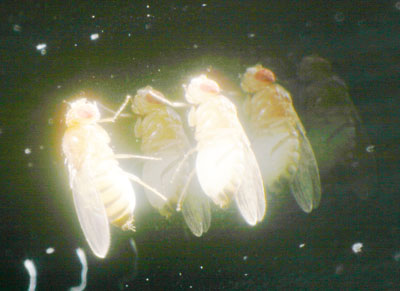 Pondering this led to another thought, and a brief experiment shown here. Tweaking the brightness curves almost off the scale in Photoshop revealed yet another reflection staggered further right (you will note I did not remove the mirror spots in this image.) The light had dropped too faint to make it easily discernible, but the digital sensor still captured it. Sometimes there are subtle traces captured in digital images that can be brought out with editing, and I’ve used this to evaluate several ‘ghost’ and ‘UFO’ photos (which is not often appreciated.)
Pondering this led to another thought, and a brief experiment shown here. Tweaking the brightness curves almost off the scale in Photoshop revealed yet another reflection staggered further right (you will note I did not remove the mirror spots in this image.) The light had dropped too faint to make it easily discernible, but the digital sensor still captured it. Sometimes there are subtle traces captured in digital images that can be brought out with editing, and I’ve used this to evaluate several ‘ghost’ and ‘UFO’ photos (which is not often appreciated.) Now for some more photographic reflection trivia. This next pic is a portion of a frame taken while living in Florida, a time-exposure at night on black & white film. An effect called “halation” is plainly visible, the halos around the bright lights of the streetlamps. Also visible are starburst patterns, occasionally seen in star photographs, which is an artifact of using a small aperture – I’m leaving this for a later post, because I’m still doing research on how exactly this occurs. So for now, I’ll stick with the halos because I can tell you precisely how this happens.
Now for some more photographic reflection trivia. This next pic is a portion of a frame taken while living in Florida, a time-exposure at night on black & white film. An effect called “halation” is plainly visible, the halos around the bright lights of the streetlamps. Also visible are starburst patterns, occasionally seen in star photographs, which is an artifact of using a small aperture – I’m leaving this for a later post, because I’m still doing research on how exactly this occurs. So for now, I’ll stick with the halos because I can tell you precisely how this happens. Now the fun. The emulsion of film is not perfectly opaque, and can let a little bit of light shine through it. So even when a bright light source is perfectly focused on the emulsion, which sits on the front surface of the backing acetate of film, some light goes through, re-diverging into another cone. This light can bounce off of the back of the film, or the pressure plate in the camera which holds the film flat, and reverses direction to contact the emulsion layer again from the back side. Now it’s out-of-focus, however – even that tiny bit of additional distance is enough to defocus noticeably in the scale of a 35mm film frame – and what results is a halo around the light source. If you go back up and look at the B&W image again, you’ll see the halos are all the same size, regardless of the apparent brightness of the lights; in some cases it’s almost overwhelmed by the flare.
Now the fun. The emulsion of film is not perfectly opaque, and can let a little bit of light shine through it. So even when a bright light source is perfectly focused on the emulsion, which sits on the front surface of the backing acetate of film, some light goes through, re-diverging into another cone. This light can bounce off of the back of the film, or the pressure plate in the camera which holds the film flat, and reverses direction to contact the emulsion layer again from the back side. Now it’s out-of-focus, however – even that tiny bit of additional distance is enough to defocus noticeably in the scale of a 35mm film frame – and what results is a halo around the light source. If you go back up and look at the B&W image again, you’ll see the halos are all the same size, regardless of the apparent brightness of the lights; in some cases it’s almost overwhelmed by the flare. It is worth noting that both flare, and the circles caused by unfocused point light sources, are often mistaken for UFOs and ghosts and other paranormal things. These effects can occur anytime, and often do, but because they involve diffuse light they’re usually overwhelmed by the sharper, more intense light from the focused parts of the image, and are most noticeable only when small bright points of light exist against a dark background where no other light interferes. Many intrepid ghost hunters with no knowledge of simple optics capture ‘orbs’ when their strobes illuminate airborne dust too close to the camera to be focused, visible because the rest of the frame is dark. It’s a very easy effect to duplicate; the image seen here was created with corn starch blown into the air. Either that or my apartment was haunted out the ass…
It is worth noting that both flare, and the circles caused by unfocused point light sources, are often mistaken for UFOs and ghosts and other paranormal things. These effects can occur anytime, and often do, but because they involve diffuse light they’re usually overwhelmed by the sharper, more intense light from the focused parts of the image, and are most noticeable only when small bright points of light exist against a dark background where no other light interferes. Many intrepid ghost hunters with no knowledge of simple optics capture ‘orbs’ when their strobes illuminate airborne dust too close to the camera to be focused, visible because the rest of the frame is dark. It’s a very easy effect to duplicate; the image seen here was created with corn starch blown into the air. Either that or my apartment was haunted out the ass…